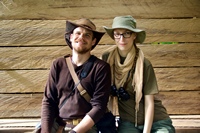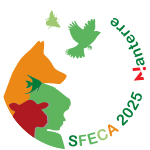Adrien Meguerditchian

Chercheur en cognition et neuropsychologie du primate, spécialiste de la communication gestuelle, de la latéralité manuelle et de leurs bases cérébrales au Laboratoire de Psychologie Cognitive (CNRS, Aix-Marseille Université).
Researcher in primate cognition and neuropsychology, specializing in gestural communication, manual laterality, and their neural bases, at the Laboratoire de Psychologie Cognitive (CNRS, Aix-Marseille University).
Aux frontières du langage dans la gestuelle des primates :
De l’éthologie aux neurosciences comparatives
Je m’intéresse aux propriétés des modes de communication de nos cousins les primates, et des signaux gestuels en particulier, et leurs liens avec certaines propriétés du langage humain. Et si le rôle de la communication gestuelle était central dans origine du langage et de son organisation cérébrale ? Les primates utilisent leurs mains non seulement pour manipuler des objets mais aussi pour communiquer. Au cours des 15 dernières années, en utilisant à la fois une approche éthologique, développementale et non invasive d’imagerie cérébrale (IRM, fNIRS), nous avons mené des recherches sur la communication gestuelle, la manipulation d’objet et les préférences manuelles chez les primates nonhumains, en particulier le babouin Papio anubis. Ces travaux seront présentés ainsi que nos dernières études chez les bébés babouin en développement incluant des données récentes en imagerie cérébrale IRM anatomique. Ces données en éthologie, psychologie comparée et neurosciences pourraient avoir des implications sur les origines du langage et le rôle singulier des gestes dans l’évolution.
***
Patrizia d'Ettorre

Professeure et spécialiste de la sociobiologie de la communication, des messagers chimiques, et de la cognition, chez les insectes sociaux notamment la fourmi, au Laboratoire d'Ethologie Expérimentale et Comparée (Université Sorbonne Paris Nord).
Professor and specialist in the sociobiology of communication, chemical signals, and cognition in social insects, particularly ants, at the Laboratory of Experimental and Comparative Ethology (Sorbonne Paris Nord University).
The Cognitive Ant
If we observe ants in their natural environment, they appear to display intelligent behaviour. But are they cognitively flexible? Do they vary individually in cognitive performance? How do their cognitive abilities relate to their personalities? And how do individual and collective intelligence interact and influence each other? Join me on a fascinating journey to explore these intriguing questions.
As is typical in social insects, division of labour in ants is driven by temporal polyethism, with different behavioural caste, such as foragers and nurses, showing distinct traits, including differences in learning abilities. However, even within each behavioural group (e.g., foragers), cognitive performance varies significantly. We discovered that this variation is closely linked to personality. In carpenter ants, stable individual differences in exploratory activity predict individual learning performance. Additionally, variations in personality traits are linked to cognitive judgment bias, the tendency to expect either positive or negative outcomes when faced with ambiguous information.
Tool-use is a representative example of remarkable cognitive abilities in animals, and ants are no exception. For instance, Aphaenogaster ants use debris such as sand grains and leaf fragments to collect and transport liquid food to their nest. Our research demonstrated that this tool-use is flexible rather than behaviourally fixed: workers actively learn to select the most effective tools based on their soaking properties. Next, we investigated individual variation in tool-use among ant foragers and uncovered a connection between personality traits and the tendency to use tools. Finally, we discovered a previously unknown form of collective tool-use in carpenter ants, enabling groups of ants to solve a task similar to the classic box-and-banana problem, initially described in chimpanzees. Taken together, these findings suggest that ants exhibit goal-directed behaviours and possess multifaceted cognitive abilities, which can vary between individuals. Unravelling the evolutionary significance of this individual variability represents an exciting challenge.
***
Mark O’Hara & Berenika Mioduszewska

Chercheurs en cognition animale et spécialisés dans l’étude des facteurs environnementaux influençant certaines capacités cognitives comme l’utilisation d’outils chez les Cacatoès de Goffin. Membres de la Cognition Team de l’Université de Médecine Vétérinaire de Vienne (Autriche). Cofondateurs du Goffin Lab à Tanimbar (Indonésie) dont Mark O'Hara est le directeur.
Researchers in animal cognition, specializing in the study of environmental factors influencing cognitive abilities in Goffin's cockatoos, such as tool use. Members of the Cognition Team at the University of Veterinary Medicine Vienna (Austria). Co-founders of the Goffin Lab in Tanimbar (Indonesia), headed by Mark O'Hara.
Wild minds: A decade with cockatoos on the Tanimbar Islands
The ability to craft and use tools has long been considered a hallmark of humanity. Information on tool use in non-human primates provides insights into our shared evolutionary roots, while its independent emergence in phylogenetically distant species highlights broader drivers of cognitive skills. The Goffin’s cockatoo (Cacatua goffiniana; hereafter: Goffin) has become a key model species in comparative research on technical intelligence and tool-use behaviours. However, to uncover the evolutionary drivers of such abilities, it is essential to examine the ecological challenges and opportunities species encounter in their natural environments. Until recently, little was known about Goffins in the wild. Here we revisit the past decade of fieldwork conducted on the remote Tanimbar Islands in southeast Indonesia. Our objective is to share the scientific highlights alongside reflections on our personal journey – marked by both setbacks and successes. This research has provided evidence that Goffins are opportunistic generalists, with innovation rates comparable to those observed in hand-raised individuals. Notably, wild Goffins were observed to manufacture and use tool sets to extract embedded seeds from a tropical fruit – a behaviour previously undocumented in wild psittacines. These observations support the hypothesis that tropical islands may serve as incubators for avian tool-use potential. Furthermore, actions stemming from seed-shelling behaviour could scaffold the development of technical skills in this species. In addition to maintaining and expanding the field research station, we also support local conservation efforts and aim to develop effective systems to study cognitive ecology of free-ranging Goffins.
***



